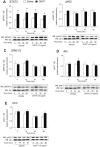The cytokine ciliary neurotrophic factor (CNTF) activates hypothalamic urocortin-expressing neurons both in vitro and in vivo
- PMID: 23626705
- PMCID: PMC3633986
- DOI: 10.1371/journal.pone.0061616
The cytokine ciliary neurotrophic factor (CNTF) activates hypothalamic urocortin-expressing neurons both in vitro and in vivo
Abstract
Ciliary neurotrophic factor (CNTF) induces neurogenesis, reduces feeding, and induces weight loss. However, the central mechanisms by which CNTF acts are vague. We employed the mHypoE-20/2 line that endogenously expresses the CNTF receptor to examine the direct effects of CNTF on mRNA levels of urocortin-1, urocortin-2, agouti-related peptide, brain-derived neurotrophic factor, and neurotensin. We found that treatment of 10 ng/ml CNTF significantly increased only urocortin-1 mRNA by 1.84-fold at 48 h. We then performed intracerebroventricular injections of 0.5 mg/mL CNTF into mice, and examined its effects on urocortin-1 neurons post-exposure. Through double-label immunohistochemistry using specific antibodies against c-Fos and urocortin-1, we showed that central CNTF administration significantly activated urocortin-1 neurons in specific areas of the hypothalamus. Taken together, our studies point to a potential role for CNTF in regulating hypothalamic urocortin-1-expressing neurons to mediate its recognized effects on energy homeostasis, neuronal proliferaton/survival, and/or neurogenesis.
Conflict of interest statement
Figures





Similar articles
-
Unlike leptin, ciliary neurotrophic factor does not reverse the starvation-induced changes of serum corticosterone and hypothalamic neuropeptide levels but induces expression of hypothalamic inhibitors of leptin signaling.Diabetes. 2000 Nov;49(11):1890-6. doi: 10.2337/diabetes.49.11.1890. Diabetes. 2000. PMID: 11078456
-
Ciliary neurotrophic factor recruitment of glucagon-like peptide-1 mediates neurogenesis, allowing immortalization of adult murine hypothalamic neurons.FASEB J. 2009 Dec;23(12):4256-65. doi: 10.1096/fj.09-133454. Epub 2009 Aug 24. FASEB J. 2009. PMID: 19703933
-
Regulation of corticotropin-releasing factor and urocortin 2/3 mRNA by leptin in hypothalamic N39 cells.Peptides. 2013 Dec;50:1-7. doi: 10.1016/j.peptides.2013.09.010. Epub 2013 Sep 29. Peptides. 2013. PMID: 24083959
-
The ciliary neurotrophic factor and its receptor, CNTFR alpha.Pharm Acta Helv. 2000 Mar;74(2-3):265-72. doi: 10.1016/s0031-6865(99)00050-3. Pharm Acta Helv. 2000. PMID: 10812968 Review.
-
The Roles of Ciliary Neurotrophic Factor - from Neuronutrition to Energy Metabolism.Protein Pept Lett. 2022;29(10):815-828. doi: 10.2174/0929866529666220905105800. Protein Pept Lett. 2022. PMID: 36065930 Review.
Cited by
-
Korean red ginseng promotes hippocampal neurogenesis in mice.Neural Regen Res. 2020 May;15(5):887-893. doi: 10.4103/1673-5374.268905. Neural Regen Res. 2020. PMID: 31719254 Free PMC article.
-
Action of Administered Ciliary Neurotrophic Factor on the Mouse Dorsal Vagal Complex.Front Neurosci. 2016 Jun 27;10:289. doi: 10.3389/fnins.2016.00289. eCollection 2016. Front Neurosci. 2016. PMID: 27445662 Free PMC article.
-
Female-specific role of ciliary neurotrophic factor in the medial amygdala in promoting stress responses.Neurobiol Stress. 2022 Jan 31;17:100435. doi: 10.1016/j.ynstr.2022.100435. eCollection 2022 Mar. Neurobiol Stress. 2022. PMID: 35146079 Free PMC article.
-
Neutrophil modulation of behavior and cognition in health and disease: The unexplored role of an innate immune cell.Immunol Rev. 2022 Oct;311(1):177-186. doi: 10.1111/imr.13123. Epub 2022 Aug 4. Immunol Rev. 2022. PMID: 35924463 Free PMC article. Review.
-
Adult neurogenesis: a real hope or a delusion?Neural Regen Res. 2024 Jan;19(1):6-15. doi: 10.4103/1673-5374.375317. Neural Regen Res. 2024. PMID: 37488837 Free PMC article. Review.
References
-
- Sleeman MW, Anderson KD, Lambert PD, Yancopoulos GD, Wiegand SJ (2000) The ciliary neurotrophic factor and its receptor, CNTFR alpha. Pharm Acta Helv 74: 265–272. - PubMed
-
- Kokoeva MV, Yin H, Flier JS (2005) Neurogenesis in the hypothalamus of adult mice: potential role in energy balance. Science 310: 679–683. - PubMed
-
- Ettinger MP, Littlejohn TW, Schwartz SL, Weiss SR, McIlwain HH, et al. (2003) Recombinant variant of ciliary neurotrophic factor for weight loss in obese adults: a randomized, dose-ranging study. Jama 289: 1826–1832. - PubMed
Publication types
MeSH terms
Substances
Grants and funding
LinkOut - more resources
Full Text Sources
Other Literature Sources

